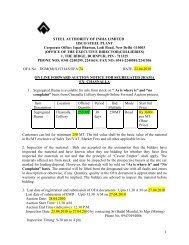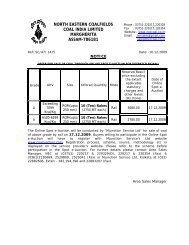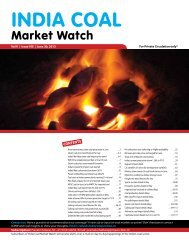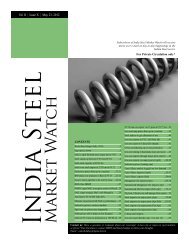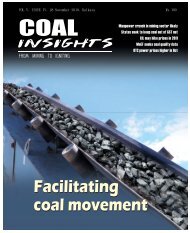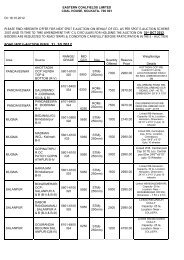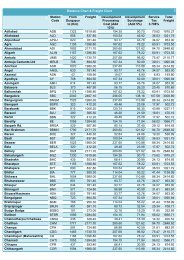India's largest coal handling agency - Mjunction
India's largest coal handling agency - Mjunction
India's largest coal handling agency - Mjunction
You also want an ePaper? Increase the reach of your titles
YUMPU automatically turns print PDFs into web optimized ePapers that Google loves.
Expert Speak<br />
Refractory lining work for lower oven doors in progress in COP<br />
body was replaced with insulating castable Insulite-15. Top<br />
surface was finished with 70 mm LC-45 dense castable. About<br />
78 upper oven doors have been replaced with the new lining<br />
since September 31, 2009. None of these freshly lined doors<br />
have failed so far.<br />
There is a proposal to use ceramic fibre modules for upper<br />
door lining. Orders have already been placed for imported<br />
and indigenous modules, particularly for the upper door<br />
lining, the results of which can be seen only after installation.<br />
Lower Oven Doors<br />
The first instance of damage of lower oven door commenced<br />
almost within two to three months of the first start-up of coke<br />
oven battery nos. 7 and 8. Similar to the upper door lining,<br />
changes were made in the lower door lining also, mainly<br />
the peripherals, which receive maximum external abrasions.<br />
These were lined with dense LC-45 castable on top of Hysil<br />
boards. A pictorial representation of the extent of repairs done<br />
almost over a year after September 31, 2009 is given herewith.<br />
None of these freshly lined doors have failed till date.<br />
Bridge Pipes<br />
It was observed that the ceramic fibre lining of the bridge<br />
pipes was failing repeatedly and fallen refractory material<br />
was blocking the suction ports. It was also observed initially<br />
that the temperature inside the bridge pipes was shooting up<br />
as high as 1450°C leading to fusion and melting down of not<br />
only the refractory material, but also the mild steel body of the<br />
bridge pipes, thereby creating gaping holes.<br />
It was also observed that certain amounts of combustibles<br />
were being carried over to the bridge pipe region. The<br />
operating procedure being followed at that point of time<br />
(before September 31, 2009) had a flaw, although it was as<br />
per the instructions given by the Chinese suppliers. The two<br />
primary air windows provided in the upper oven doors were<br />
completely closed for the initial three hours after charging of<br />
ovens. Since the plant was being operated almost at full load,<br />
one oven was being pushed and charged every 45 minutes. As<br />
a result, unburnt volatiles escaped continuously to the bridge<br />
pipe and branch headers. Another mistake which further<br />
aggravated the problem was that a tertiary hole was made by<br />
some <strong>agency</strong> at the bottom of the uptake just after the fourlinked<br />
arch, which provided additional combustion air to the<br />
unburnt volatiles.<br />
A third observation was that when bridge pipes were<br />
being changed, flue hole cleaning was overlooked at times and<br />
bridge pipes were also being changed only on one side, that is,<br />
either the coke side or the pusher side, ignoring the condition<br />
of the other side. This resulted in more flow of gas through<br />
one of the bridge pipes leading to higher temperature and<br />
meltdown. The following steps were undertaken to overcome<br />
the problem of bridge pipe failure:<br />
a) Immediate plugging of tertiary holes with strict instructions<br />
to never open them in future.<br />
b) Keeping the primary air windows open right from the<br />
time after charging, closing it fully only when the oven<br />
is ready and regulating it in between as per combustion<br />
requirement.<br />
c) Keeping the levels of the combustibles in flue gas, particularly<br />
carbon monoxide and hydrogen at trace levels.<br />
d) To take up bridge pipe replacement either simultaneously<br />
on both the coke side and the pusher side or at a small gap<br />
of maximum one week.<br />
e) Use of dense castable LC-45 in the top layer in contact with<br />
the hot gas.<br />
f) To do compulsory suction port cleaning with every bridge<br />
pipe replacement.<br />
The above mentioned steps have brought in drastic<br />
improvements in the condition and life of the bridge pipes<br />
and their lining. Over the last one year, more than 100 out of<br />
a total of 192 bridge pipes have been replaced, none of which<br />
have failed as yet. With full load operation at 36 pushing per<br />
day, some damages temporarily resurfaced but were quickly<br />
controlled. The key to the solution to the problem was basically<br />
lowering the temperature of the flue gas to about 1100°C to<br />
1150°C which is as per the design and the liner material can<br />
withstand the same.<br />
The author is working as Vice President in the coke manufacturing<br />
unit of Bhushan Power and Steel Limited, Jharsuguda, Orissa.<br />
Right from its inception in 2007, the plant has been facing problems<br />
of massive failure of refractory lining of bridge pipes, upper oven<br />
doors, lower oven doors and branch headers. Many trial and error<br />
processes were carried out with different material and massive<br />
maintenance work was taken up to combat the failures, but fruitful<br />
results were not coming up. Finally after doing an in-depth study<br />
of various operational and maintenance aspects, a viable solution to<br />
this endemic problem could be found with the combined efforts of all<br />
related disciplines.<br />
The author is grateful to M/s K. Vijayan, S. Mukherjee, Sanjeev<br />
Srivastav, Sanjit Kumar and the entire coke oven team for their<br />
relentless efforts in bringing about the improvements in the operation<br />
and maintenance of the coke oven plant.<br />
COAL INSIGHTS 57 October 2010



